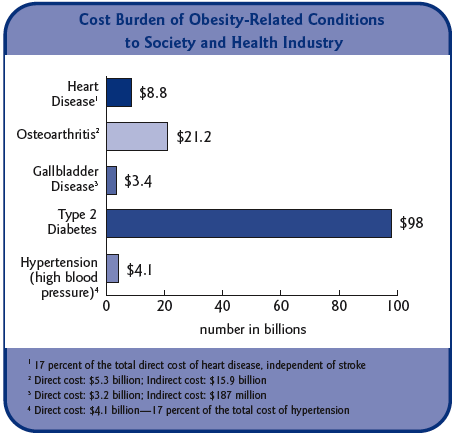Rising Obesity Rates Prompt Call for Serious Policy Changes

Obesity-related diseases cost billions of dollars every year. This graph, from the Get American Fit Foundation, shows 2001 costs.
In an ambitious 478-page report, the Institute of Medicine (IOM) refutes the idea that obesity is largely the result of a lack of willpower on the part of individuals. Instead, it embraces policy proposals that have met with stiff resistance from the food industry and lawmakers, arguing that multiple strategies will be needed to make the U.S. environment less “obesogenic.”
A study funded by the CDC and released on Monday projected that by 2030, 42 percent of American adults will be obese, compared to 34 percent today and 11 percent will be severely obese, compared to 6 percent today. Obesity is defined as having a body mass index – a measure of height to weight – of 30 or greater. Overweight means a BMI of 25 to 29.9.
- Taxing sugar-sweetened beverages since “their link to obesity is stronger than that observed for any other food or beverage.” They stated that a penny-per-ounce tax (meaning a 20 ounce soda has a 20 cent tax) could reduce consumption by 24 percent
- Revolutionizing fam policies to allow farmers to grow fruits and vegetables. Currently, subsidized farming legislation states farmers may only grow wheat, cotton and corn products if they receive federal funding. As a result, the United States does not grow enough fruits and vegetables to feed the entire population
- Creating so-called “walkable neighborhoods,” in which developers would be given tax incentives to create sidewalks and safe bike lanes to encourage exercise when people travel shorter distances. Twenty percent of trips between school and home among kids 5 to 15 were on foot in 1977, but that number dropped to just 12.5 percent by 2001
- Making schools the focus of anti-obesity efforts is critical, the report says. Preventing obesity at a young age is easier than reversing it, but the most recent data shows only 4 percent of elementary schools, 8 percent of middle schools and 2 percent of high schools provide daily physical education for all students.
The report notes that some employers are finding innovative ways to encourage weight loss among employees, including reduced premiums, free disease management services, and even cash for weight loss. Medicaid and Medicare do not offer weight loss incentives, which excludes a number of qualified individuals from participating in such programs.
Read more: MSNBC




0 comments